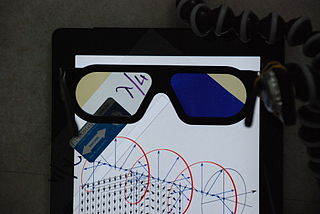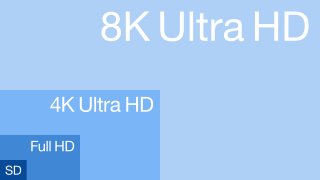
Digital Video Broadcasting (DVB) is a set of international open standards for digital television. DVB standards are maintained by the DVB Project, an international industry consortium, and are published by a Joint Technical Committee (JTC) of the European Telecommunications Standards Institute (ETSI), European Committee for Electrotechnical Standardization (CENELEC) and European Broadcasting Union (EBU).
Dolby Pro Logic is a surround sound processing technology developed by Dolby Laboratories, designed to decode soundtracks encoded with Dolby Surround. Dolby Stereo was developed by Dolby in 1976 for analog cinema sound systems. The format was adapted for home use in 1982 as Dolby Surround when HiFi capable consumer VCRs were introduced. It was further improved with the Pro Logic decoding system in 1987.
The Grand Alliance (GA) was a consortium created in 1993 at the behest of the Federal Communications Commission (FCC) to develop the American digital television and HDTV specification, with the aim of pooling the best work from different companies. It consisted of AT&T Corporation, General Instrument Corporation, Massachusetts Institute of Technology, Philips Consumer Electronics, David Sarnoff Research Center, Thomson Consumer Electronics, and Zenith Electronics Corporation. The Grand Alliance DTV system is the basis for the ATSC standard.
Digital Living Network Alliance (DLNA) was founded by a group of PC and consumer electronics companies in June 2003 to develop and promote a set of interoperability guidelines for sharing digital media among multimedia devices under the auspices of a certification standard. DLNA certified devices include smartphones, tablets, PCs, TV sets and storage servers.

An active shutter 3D system is a technique of displaying stereoscopic 3D images. It works by only presenting the image intended for the left eye while blocking the right eye's view, then presenting the right-eye image while blocking the left eye, and repeating this so rapidly that the interruptions do not interfere with the perceived fusion of the two images into a single 3D image.

A polarized 3D system uses polarization glasses to create the illusion of three-dimensional images by restricting the light that reaches each eye.
A Technology and Engineering Emmy Award is given by the National Academy of Television Arts and Sciences (NATAS) for outstanding achievement in technical or engineering development. An award can be presented to an individual, a company, or to a scientific or technical organization for developments and/or standardization involved in engineering technologies which either represent so extensive an improvement on existing methods or are so innovative in nature that they materially have affected the transmission, recording, or reception of television. The award is determined by a special panel composed of highly qualified, experienced engineers in the television industry.
EcoHealth Alliance is a non-governmental organization which employs a 'One Health' approach to protecting the health of people, animals, and the environment from emerging infectious diseases. The nonprofit is a global organization focused on scientific research that aims to prevent pandemics and promote conservation in hotspot regions worldwide.

NAB Show is an annual trade show produced by the National Association of Broadcasters. It takes place in April, and has been held since 1991 at the Las Vegas Convention Center in Las Vegas, Nevada. The show's tagline is "Where Content Comes to Life". NAB show is the largest show for media, entertainment and technology. The NAB shows covers: broadcast TV, radio, production, post production, news gathering, streaming, cable TV, satellite TV, film restoration, data storage, data management, weather forecasting, industrial TV, FX, CGI, connected media, cybersecurity and more. NAB had 103,000 attendees from 161 countries and more than 1,806 exhibitors in 2016. There are also exhibitors in Las Vegas hotels not counted in the official convention center displays. In addition to the exhibitors' booths, there are lectures, panel discussions and workshops. In 2017, there will be over 200 of these sessions. Before 1991 the show had moved around to a number of cities: Washington DC, Chicago, New York, Atlantic City, Dallas, Cleveland, Cincinnati, Los Angeles, Houston, San Francisco, St. Louis, White Sulfur Springs, W. Va., and once in West Baden Springs, Indiana

Mobile television is television watched on a small handheld or mobile device. It includes pay TV service delivered via mobile phone networks or received free-to-air via terrestrial television stations. Regular broadcast standards or special mobile TV transmission formats can be used. Additional features include downloading TV programs and podcasts from the Internet and storing programming for later viewing.
Digital 3D is a non-specific 3D standard in which films, television shows, and video games are presented and shot in digital 3D technology or later processed in digital post-production to add a 3D effect.

Sustainable packaging is the development and use of packaging which results in improved sustainability. This involves increased use of life cycle inventory (LCI) and life cycle assessment (LCA) to help guide the use of packaging which reduces the environmental impact and ecological footprint. It includes a look at the whole of the supply chain: from basic function, to marketing, and then through to end of life (LCA) and rebirth. Additionally, an eco-cost to value ratio can be useful The goals are to improve the long term viability and quality of life for humans and the longevity of natural ecosystems. Sustainable packaging must meet the functional and economic needs of the present without compromising the ability of future generations to meet their own needs. Sustainability is not necessarily an end state but is a continuing process of improvement.

3D television (3DTV) is television that conveys depth perception to the viewer by employing techniques such as stereoscopic display, multi-view display, 2D-plus-depth, or any other form of 3D display. Most modern 3D television sets use an active shutter 3D system or a polarized 3D system, and some are autostereoscopic without the need of glasses. As of 2019, most 3D TV sets and services are no longer available.
Endeavor Streaming is a digital video technology company headquartered in Plainview, New York, USA.

Hybrid Broadcast Broadband TV (HbbTV) is both an industry standard and promotional initiative for hybrid digital TV to harmonise the broadcast, IPTV, and broadband delivery of entertainment to the end consumer through connected TVs and set-top boxes. The HbbTV Association, comprising digital broadcasting and Internet industry companies, has established a standard for the delivery of broadcast TV and broadband TV to the home, through a single user interface, creating an open platform as an alternative to proprietary technologies. Products and services using the HbbTV standard can operate over different broadcasting technologies, such as satellite, cable, or terrestrial networks.

XPAND 3D developed active-shutter 3D solutions for multiple purposes. The company was founded by Maria Costeira and Ami Dror in 1995 as X6D Limited. The company deployed over 15,000 cinemas worldwide.
Nvidia 3D Vision is a discontinued stereoscopic gaming kit from Nvidia which consists of LC shutter glasses and driver software which enables stereoscopic vision for any Direct3D game, with various degrees of compatibility. There have been many examples of shutter glasses. Electrically controlled mechanical shutter glasses date back to the middle of the last century. LCD shutter glasses appeared in the 1980s, one example of which is Sega's SegaScope. This was available for Sega's game console, the Master System. The NVIDIA 3D Vision gaming kit introduced in 2008 made this technology available for mainstream consumers and PC gamers.
FPR is a technology promoted by LG that is employed in its line of 3D televisions based on circular polarization. It shows left and right images through different patterns in a circular polarizer. Left/right polarized glasses allow the left and right images to then be seen by the left and right eyes separately. Both images are combined in the brain and generate the 3D effect. The FPR technology uses the precise film which polarizes different pixels differently to show a different image for each eye. FPR 3D tech is said to deliver a brighter screen with less cross talk, less ghosting, and no flickering.
The M-3DI Standard, announced by Panasonic Corporation together with XpanD 3D in March 2011, aims to provide industry-wide compatibility and standardisation of LC (Active) Shutter Glasses hardware between manufacturers.

Ultra-high-definition television today includes 4K UHD and 8K UHD, which are two digital video formats with an aspect ratio of 16:9. These were first proposed by NHK Science & Technology Research Laboratories and later defined and approved by the International Telecommunication Union (ITU). It is a digital television (DTV) standard, and the successor to high-definition television (HDTV), which in turn was the successor to standard-definition television (SDTV).










